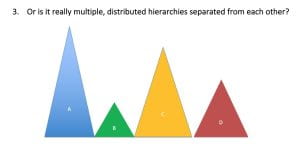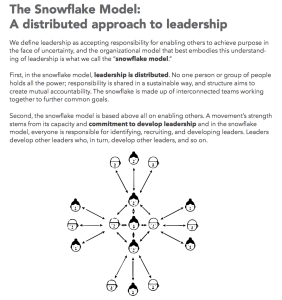written by Matt Andrews
In my last post, I argued that you should prepare to work differently. In this blog I will offer ideas on doing that. I am informed by my BSC team’s work with countries employing PDIA (problem driven iterative adaptation) in the face of problems (some crises) and the work of people like Dutch Leonard (whose video was included in the last post).

Let me start with an observation of the organizing structures typical to public organizations (school systems, local governments, national departments, and more). Most of these organizations tend to be bureaucratic hierarchies; with a defined mission determined (or managed) by the people at the top, and pursued through formal processes by people in highly specified jobs. Using words from the last blog, the authorization mechanisms, acceptance requirements, ability needs, and mobilization mechanisms are all set in place. My guess is your organization looks a little like this?
But there are variations of such structure:
- Some bureaucracies are stand-alone structures like the Figure 1 below. A single school might be an example of this. The principal sits at the top and everything is led by her/him.
- Other organizations are bigger hierarchies with multiple embedded hierarchies, as in Figure 2 below. A school district might be an example. The District commissioner leads a system in which other people lead schools B, C, and D. The leadership and coordination tasks are now split across a group.
- Other organizations are distributed hierarchies (as in diagram 3 below). A state or national government is an example. One hierarchy (A) is the education department. Another (B) is the health, another (C) is the public works department, etc. In these systems, leadership again is about a group.


Now, remember my comment from the last blog: these structures have typically all been built to address challenges or problems or to achieve objectives we know and can control and make sense of. That’s why so much of the organization is already defined (it is the manifestation of what we know we need to do to get the job done). They do not, however, work well when we are facing new threats or problems and need to mobilize people differently.
They fail, particularly, when our new problem or crisis requires working across hierarchical boundaries. This is what Dutch Leonard calls coordination in the last blog’s video. Existing coordination behavior in our systems is shaped by our bureaucratic structures—and the ways we locate abilities and authorize and motivate and mobilize how people use those resources. In many governments, for instance, all education ‘abilities’ are located in the education sector, under the authority of an education Minister or Secretary. The same is true in the health sector, and works sector, etc. People working in this sector accept that they work in that sector and know that the rules governing their activities are determined by the authorizer in that sector.
This kind of coordination structure works well when we know what we are doing and are essentially focused on continuity – doing what we know how to do again and again. Examples include managing normal day-to-day operations in a school, or running the normal operations of a hospital or hospital system, or following a well-developed public works plan.
This kind of coordination structure does not work well when we face crises, however. In such situations we need to bring abilities (people and resources) together from multiple parts of our system, and empower those abilities to do new things.
To do this, we need flat, fast and flexible structures that are not defined by what we know how to do but are rather open and adaptive to find solutions to what we do not—today—know how to do.
How can you think of building this kind of structure, now, in the face of crisis?
There are a variety of ideas out there about creating flat, fast and flexible structures. Consider the work on spiders and starfish structures, for example (by Ori Brafman and Rod Beckstom, described in this video by Beckstrom). Our PDIA teams use an approach made popular (at least at Harvard’s Kennedy School where I work) by Marshall Ganz: The snowflake model. [see this great blog-based interview with Marshall]
The snowflake model is effectively summarized in this description below, found on page 7 of the handbook Organizing: People, Power, and Change. I think you will see how the thinking behind it aligns with the thinking I have suggested about leadership in crisis in prior blog posts. Also, you may want to read this paper on broad agency in change.

Notice that the idea here is to foster the emergence of many, many teams, coordinated around a central team, to act together to learn and solve a problem you face—the crisis.
But how do you build a snowflake structure? Here is a video I shot today at home (it’s very amateurish but hopefully the content works) to explain what I mean.
Building on the video, I urge you to think first about convening and motivating a central team to help you start engaging with the crisis. In my experience, this team needs to be people close to you and who you trust. They will not necessarily be the ‘controlling team’ but are the group you start with to ask fundamental questions: What is this crisis? How does it matter to us (what will its impact be?) Who else do we need to engage to address it? [I will discuss convening this team and the initial questions I recommend they be tasked with answering in the next blog posts].
These people will then be tasked with engaging others to draw them into working on the crisis. If you have 4 people in your core team, and all are tasked with bringing in three more people (in areas that you know you need help) you quickly have twelve new people in your emerging structure (and 16 in all). If those people all engage three new people you have 48 in total, and so forth.
The connections you engage will be from other organizations, and into a new structure working across existing organizational lines to find solutions to the problems you face.
Importantly, you need to foster new norms in this kind of structure, given that it is not as formal or hierarchical as your usual bureaucratic structures. The Organizing: People, Power, and Change handbook has some great ideas about what these should look like, on page 27. I am copying these ideas here:
Distributed leadership:
In the snowflake model, decision-making responsibility is decentralized whenever possible. The core leadership team ensures the whole organization is coherent and effectively moving in the same direction towards long-term goals. Local leadership teams ensure the organization is flexible, effectively delivering on short-term objectives. Everyone is responsible for strategizing, ongoing learning, and identifying and growing new leaders and resources. The core leadership team devises strategy, while local leadership teams test that strategy on the ground. They adapt it locally and provide feedback to improve organization-wide strategy.
A sustainable number of relationships:
In the snowflake model, each person has a sustainable number of relationships. While you are likely to interact with many people in your organizing work, it’s important to focus on maintaining relationships with those on your team (one way to do this is through regular team meetings or maintenance 1:1 meetings).
Mutual accountability
The snowflake model doesn’t operate as a hierarchy, with managers delegating tasks in a top-down way and expecting results. Rather, team members are accountable to each other, mutually agree on tasks, and expect results from and provide support to each other. Someone within the core leadership team may assign a local leadership team with a task, but someone within a local leadership team is just as likely to assign the core leadership team with a task.
Clearly defined roles and responsibilities:
Each individual in a team has a specific role with clearly defined responsibilities. While the team works together towards common goals, every task should be assigned to a specific team member(s) and each team member should clearly understand their responsibilities. Roles can vary based on the strategy and tactics (e.g. in an electoral campaign, roles may include a canvass captain, phone captain, data captain, and a community organizer in a team leadership role).
Capacity for exponential growth
Because leadership in the snowflake is distributed into many small teams, and because the model is based on leadership development, the snowflake model has the capacity for exponential growth. Teams add more people, and those people break off and form their own teams, and those teams form new teams, and so on.
To conclude, and as the organizing handbook says, “The snowflake model is defined by mutual accountability and commitment, a sustainable number of relationships, clearly defined roles, and capacity for exponential growth.”
As usual, I have some questions for you to think about in relation to this blog, and the idea about creating a flat, fast and flexible snowflake organizing structure to tackle this crisis:
- Do you think that your system is usually a hierarchical bureaucracy? Draw a picture of it.
- Do you agree that there are coordination and creativity limits for your system given the current crisis?
- Do you think that you could create a snowflake-like structure in your context?
- Who would you engage into the central team in the snowflake, and why?
The Public Leadership Through Crisis blog series offers ideas for leaders questioning how they can help and what kind of leadership is required in the face of a crisis (like the COVID-19 pandemic).
